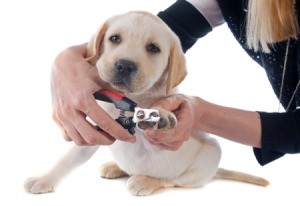 The easiest way to make a toenail trim NOT an ordeal is to start when your pet is very young. If they are acclimated to the trimmer from an early age, they won't fight you when that cute puppy becomes a hundred pound monster.
The easiest way to make a toenail trim NOT an ordeal is to start when your pet is very young. If they are acclimated to the trimmer from an early age, they won't fight you when that cute puppy becomes a hundred pound monster.
Too bad we haven't invented time travel yet! Not everybody starts off with a young, impressionable puppy or kitten. I sure didn't. I have yet to have a dog that actually liked having their toenails cut, but I have learned a few tricks over the years.
For dogs and cats, toenails have two parts. There's the hard outer layer and the softer inner layer, known as the quick. If you cut the quick, your pet is going to bleed. Don't worry, they're not going to bleed to death. If you have a little corn starch handy, you can pack the nail bed and stop the bleeding that way. A bit of tissue works just as well.
For dogs, I think the easiest thing to do (besides calling the vet or the groomer to do it for you!) is to flip the paw or position your dog so you are looking at the underside. This way, you can see where the quick is, and avoid it. For cats, a little pressure on the pad of the paw will cause the nail to come out.
It's always better to cut too little than too much, I think. Snip a bit off, and if that doesn't seem short enough, attack again in a few days. And if you're really not sure what's going on, ask your vet or groomer to show you how to do it before you give it a try on your own.
This is a page about trimming your dog's nails. Trimming your dogs nails should be a regular part of your dog's grooming. If you choose to do it yourself, it is important to learn the proper way to trim them.
This is a page about trimming your cat's nails. A cat's nails need to be trimmed regularly. Whether you pay a groomer or the vet to trim them or do them at home, there are different techniques and safety concerns.